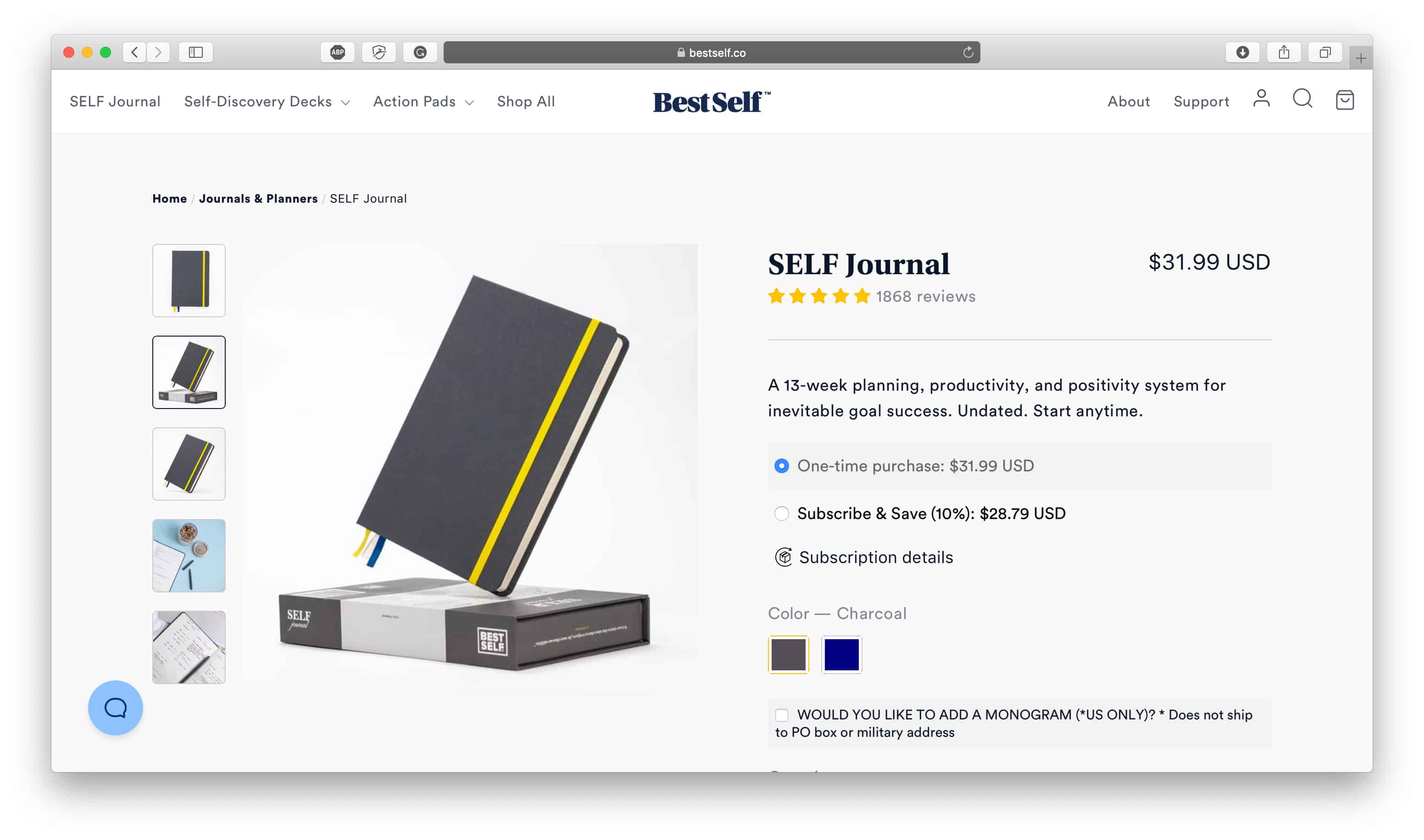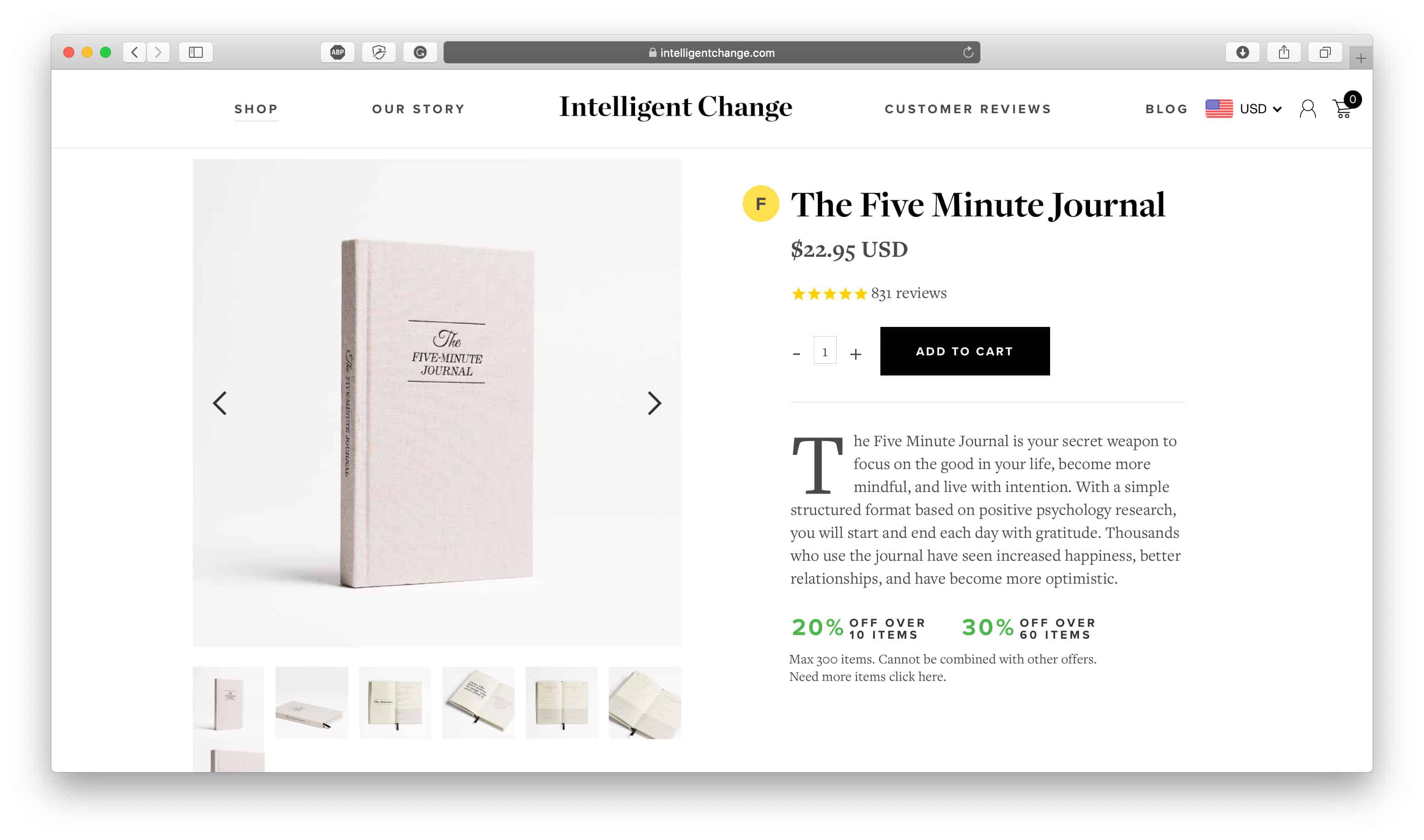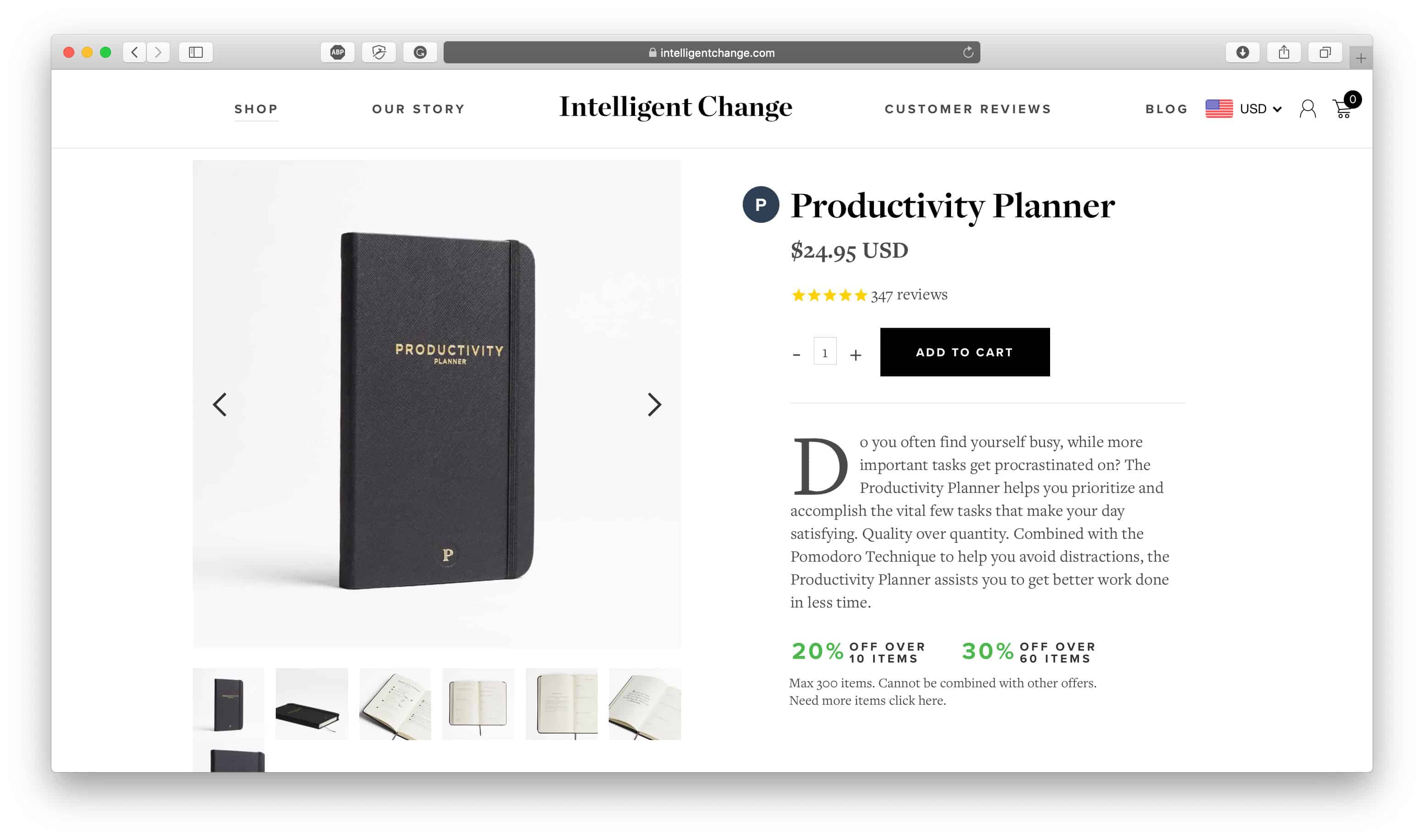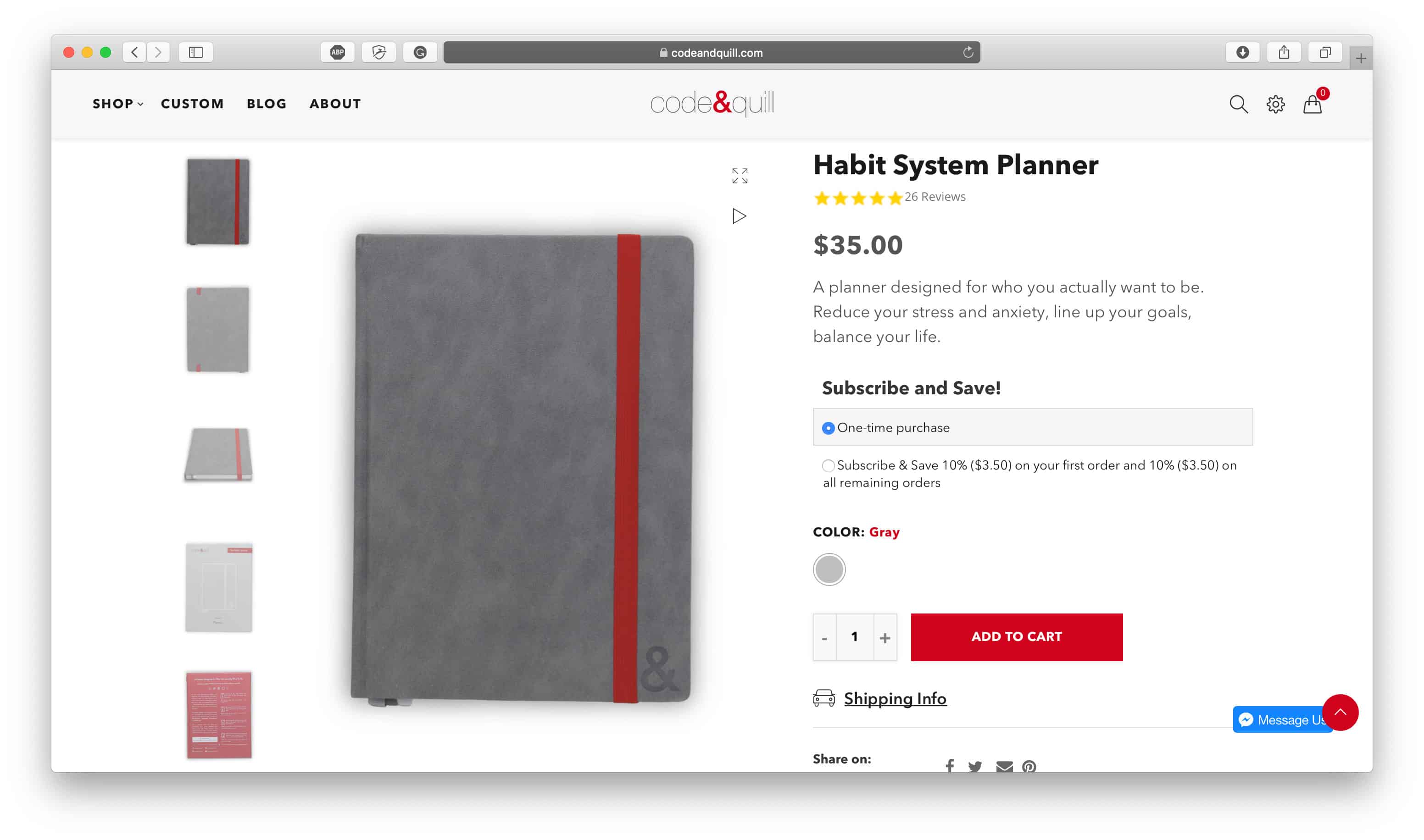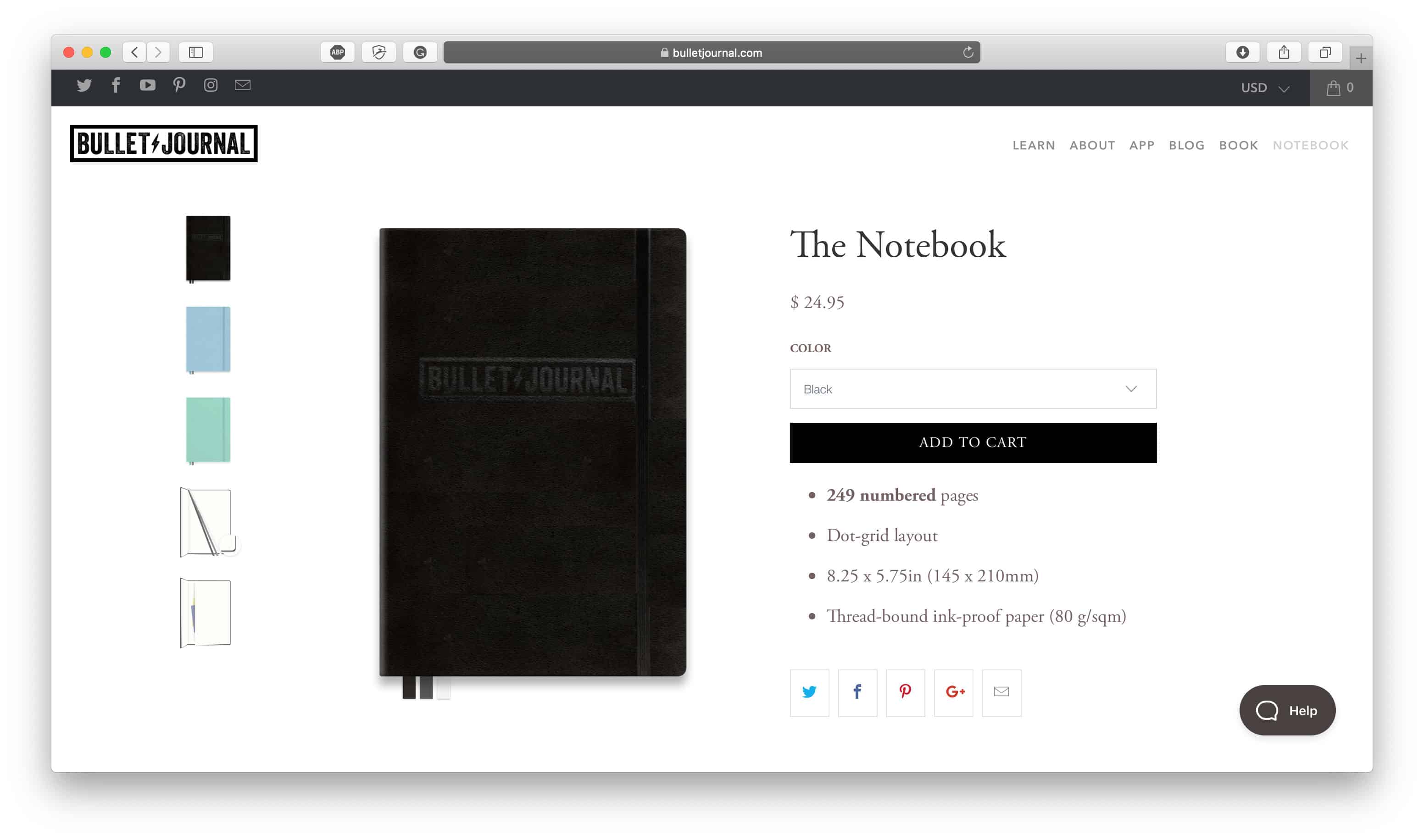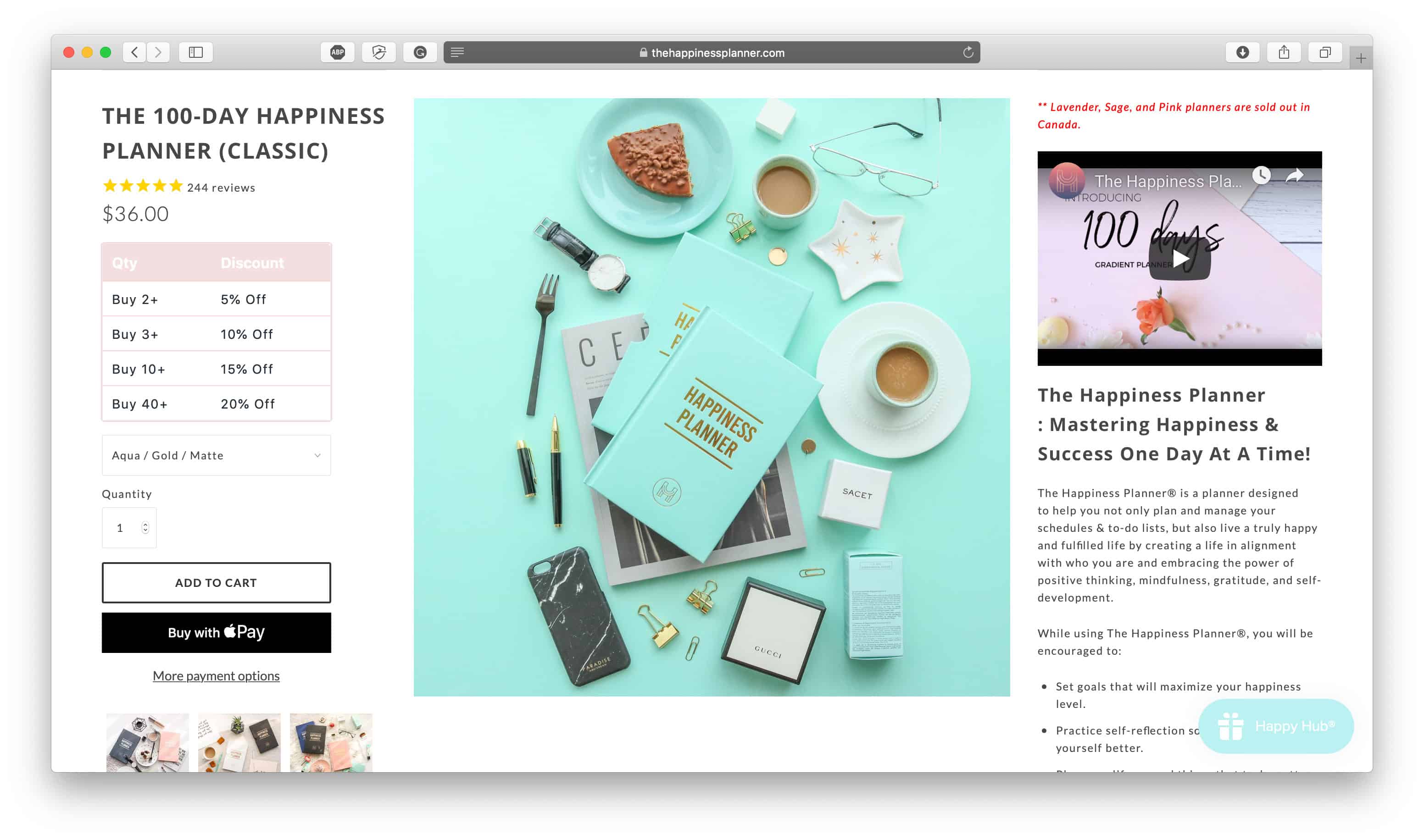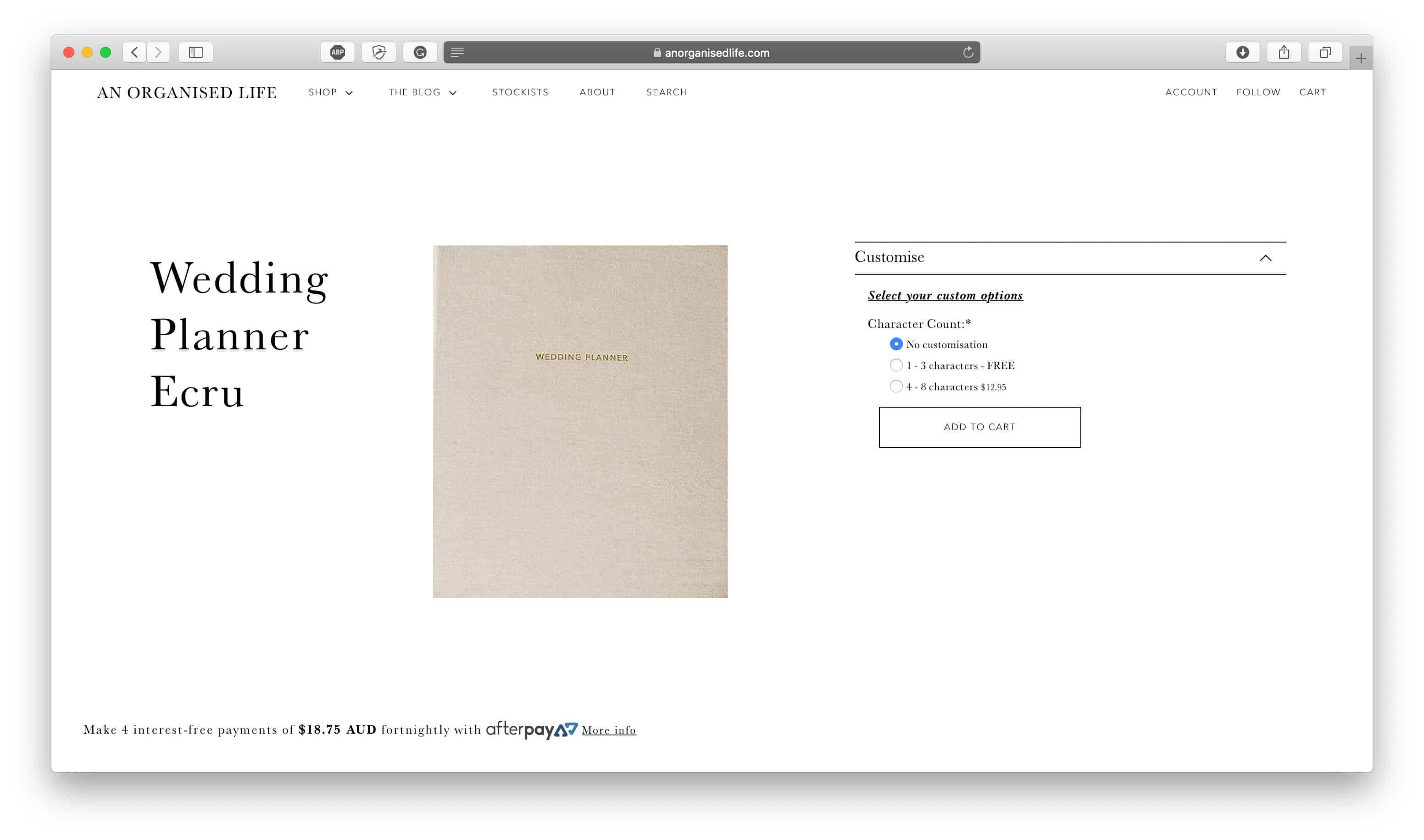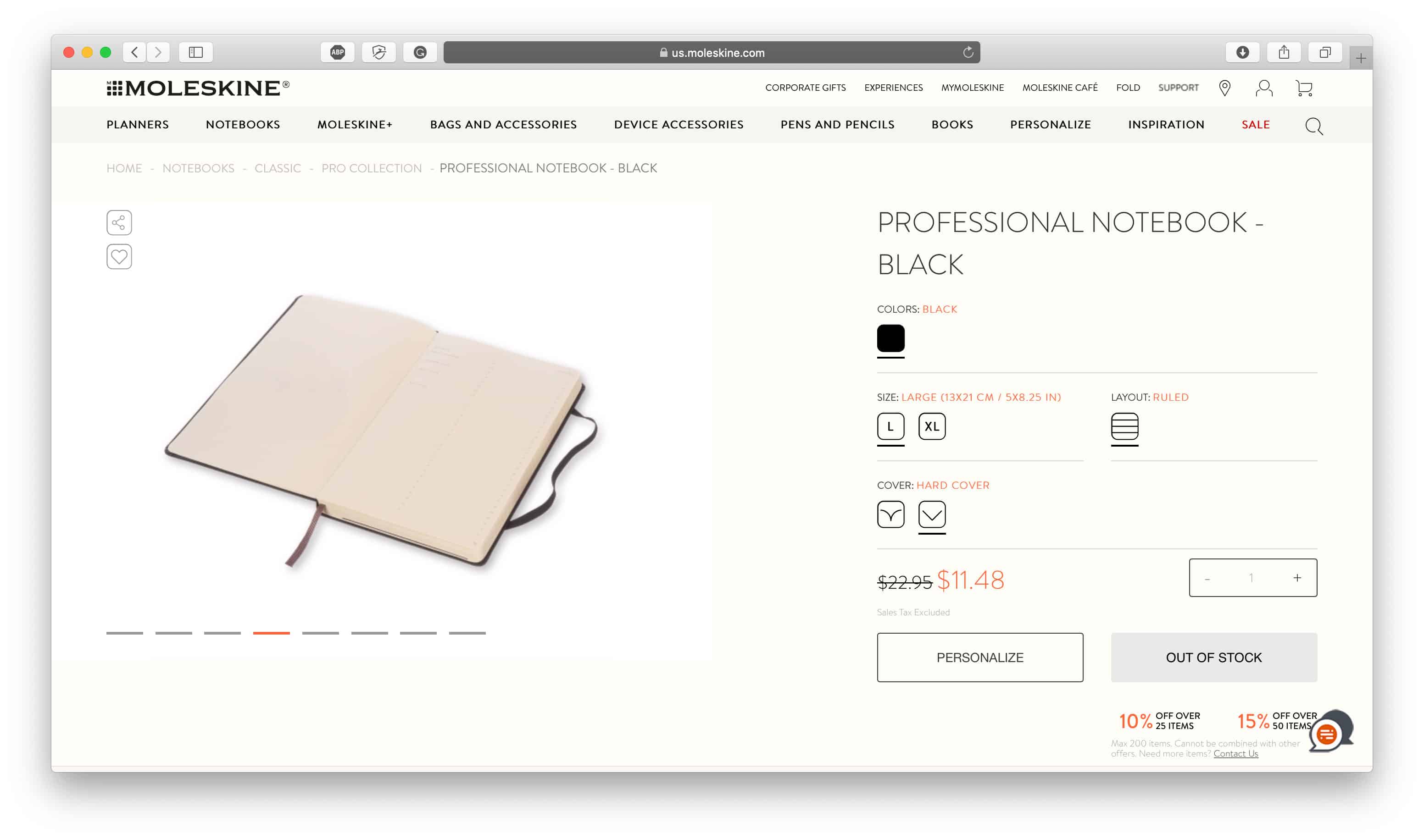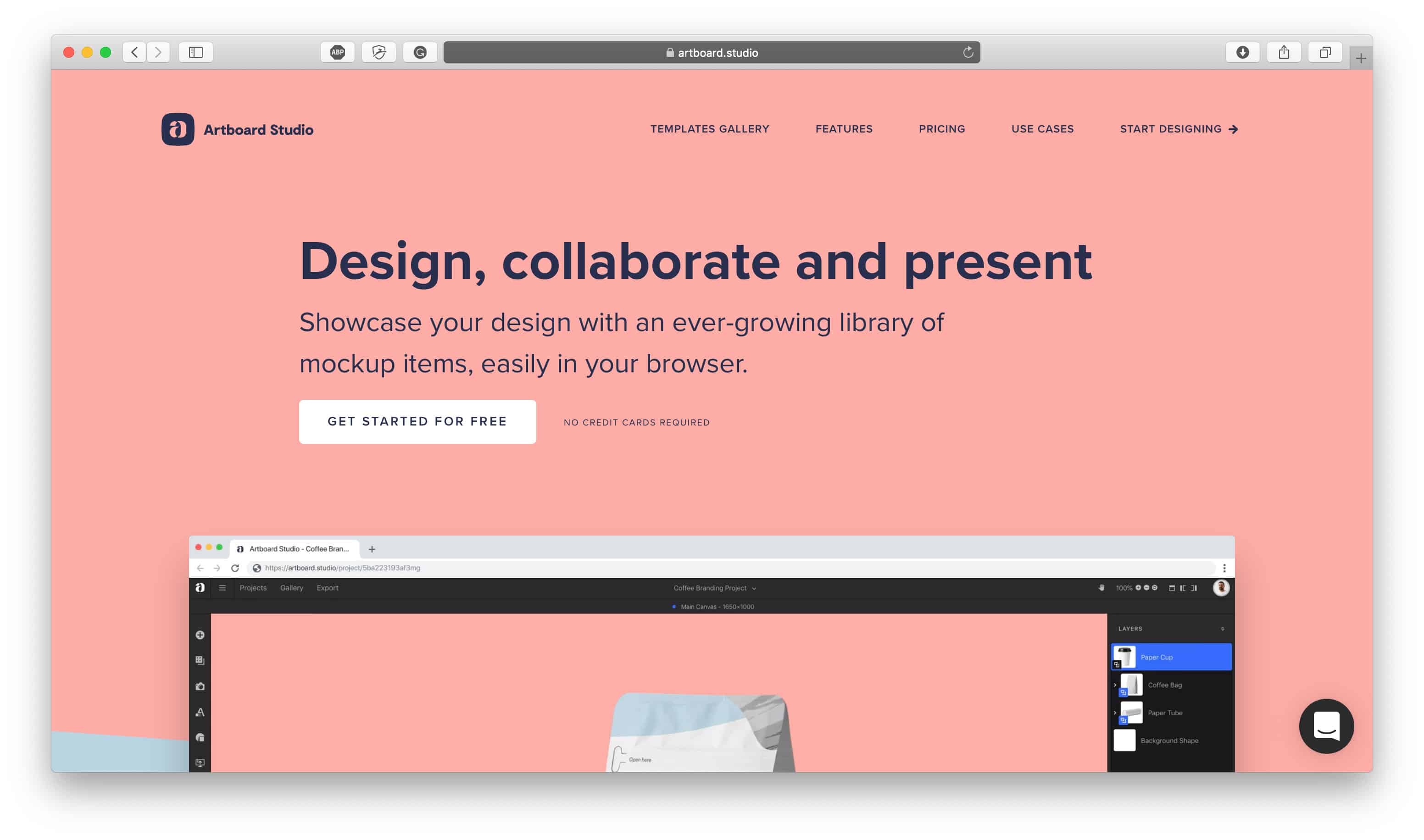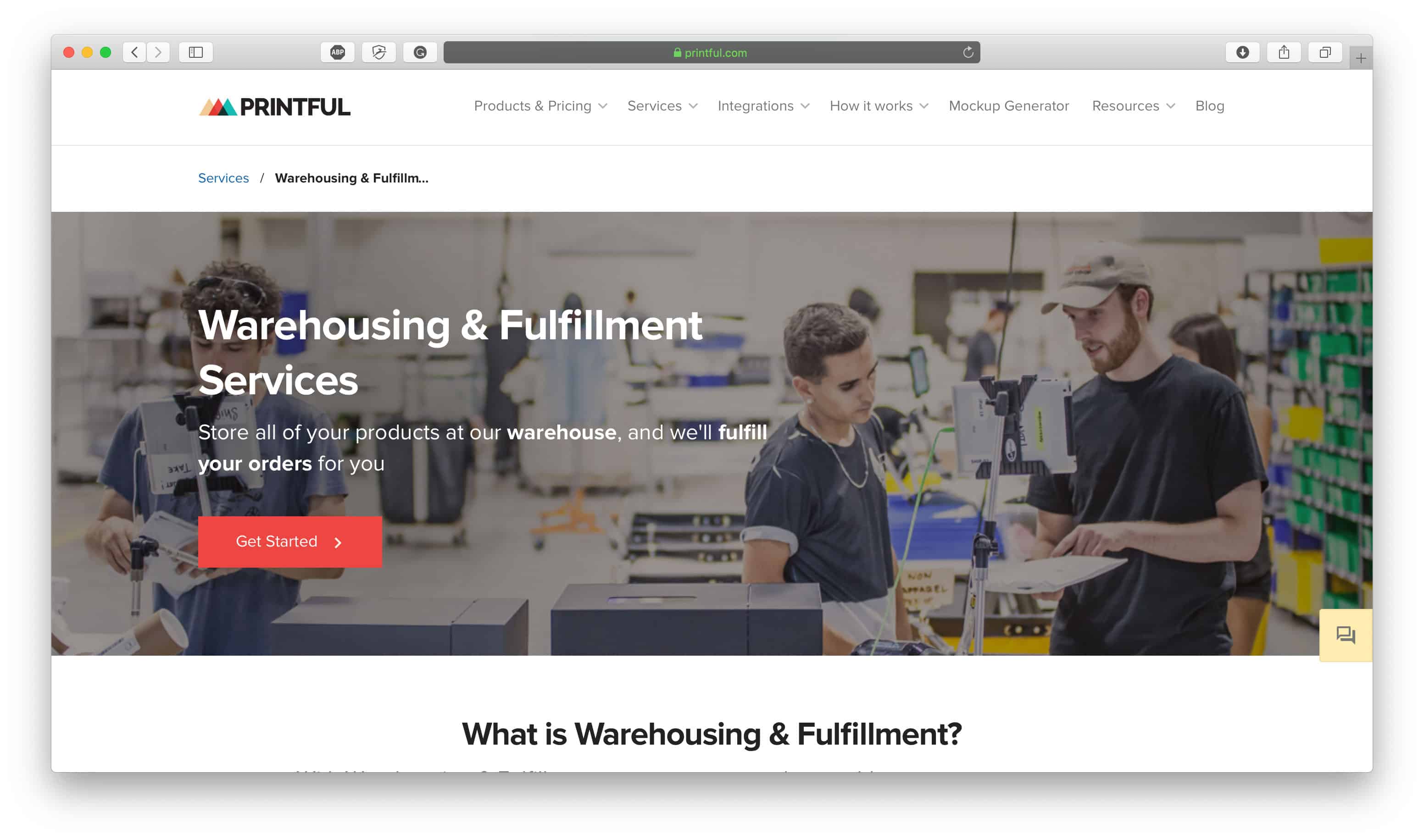
How to Start a Niche Planner & Journal Business: The Ultimate Guide
Over the last few years, niche planners have soared in popularity. These days you can purchase goal-oriented journals for almost any niche: Business, fitness, party planning—you name it, there’s probably a planner to help organize this section of your life. As a result, starting a planner business has entrepreneurs excited to capitalize on this popular and growing market.
Don’t believe us?
The stats speak for themselves:
- Back in 2016, appointment books and paper planners made roughly $342.7 million in sales. That’s a 10% increase from the year before!
- Not to mention, as of 2019, the hobby and stationery industry is now worth a whopping $113,118 million.
- Plus, revenue is predicted to grow at an annual rate of 8.6%, resulting in a market volume of $157,190 million by 2023!
So, if you’re considering breaking into the niche planner industry, now’s the time to jump on the bandwagon. Luckily for you, we’re going to break down everything you need to know to kickstart your own niche planner business in this article.
So, without further ado, let’s dive into everything you need to know to start your own planner business.
Table of Contents
- Successful Planner Businesses
- The Different Types of Planners
- Planner Design: What You Need to Consider
- How to Create Your Planner
- Finding a Supplier for Your Planner Business
- Getting a Sample of Your Planner Made
- Warehousing, Shipping & Fulfillment for Your Planner Business
- Creating Your Planner Store
- Selling & Marketing for Your Planner Business
How to Start a Planner Business from Scratch
Get Inspired by Other Successful Planner Businesses
As with any business venture, you should gain inspiration from other entrepreneurs and businesses who’ve already been successful. To help you with this, we’ve listed some of our favorite planner business below—all of whom are absolutely killing it!
Planner Business Example #1: Best Self Co.
What started as a passion project for two entrepreneurs, Cathryn and Allen, turned into a full-scale business.
Their journey is inspiring.
Like the majority of you reading this article, Cathryn and Allen dreamt of trading in their day jobs to run their own business. However, despite putting in some hard work, they didn’t feel they were getting anywhere. Days went by where they thought they hadn’t accomplished anything.
So, they founded the Best Self Co. and created the Self Journal. They hoped that this resource would help people to reflect at the end of the day and be proud of what they achieved.
Needless to say, Cathryn and Allen have smashed it.
They launched an incredible Kickstarter campaign, which now boasts as many as 6,531 backers, cumulatively pledging $322,695 to bring this project to life!
So, what is the Self Journal? In short, it’s a planner that helps you change your behaviors within three months so it’s ideal for entrepreneurs and creators who want to improve themselves and get stuff done!
Three months seemed like the optimum amount of time for Cathryn and Allen. After all, how many of us make New Year’s resolutions and abandon them months later? They believe setting yearly goals encourages the goal-setter to delay taking action. Plus, annual targets don’t take into consideration other variables that could randomly spring up further down the line.
Instead, when you work towards a three-month deadline, you’re more likely to adopt a sense of urgency and get cracking on meeting your targets.
What does the Self Journal offer?
- A 13-Week Roadmap: This is a goal-setting guide. When used correctly, it helps you to identify your goals, break them down into manageable tasks, and take action (either on a day-by-day or week-by-week basis).
- The 20 Mile March: This a blueprint on how to take consistent action.
- A Morning Routine: Following a morning routine helps put you in the right frame of mind for the day.
- An Evening Routine: This works wonders for encouraging you to reflect on your day, and prompts you to rest and recharge. That way, you can wake up the next morning feeling productive and ready to go!
More specifically, the Self Journal’s morning and evening routines nudge you to think about what you’re grateful for, in addition to goal-setting for the day, ordering your priorities, noting your daily wins, and jotting down life lessons you learned!
The Self Journal also provides a weekly layout to monitor habits, progress, and development plus it provides space to jot down ways to improve yourself.
You’re also provided with “Daily Pages” to complete for 13 weeks. That’s in addition to a “Daily Timeline.” Here you can plan your day in half-hour increments between six in the morning and nine in the evening. There’s also a simple blank grid where you can take notes, sketch, and brainstorm your ideas.
We also love that this planner isn’t dated, so you can start setting goals straight away, no matter what time of year it is! Plus, inspirational quotes are dotted throughout the planner to help motivate you to take action.
In terms of the cover quality, the Self Journal weighs four ounces and is made out of full-grain cowhide leather. It’s incredibly soft to the touch and drum dyed, so the coloring thoroughly soaks into the leather. You can also opt to personalize your planner with a monogram of your initials.
Planner Business Example #2: The Five Minute Journal
The Five Minute Journal is a highly-popular planner that places emphasis on self-improvement by practicing mindfulness, living with intention, and focusing on the lighter and brighter side of life.
It’s relatively simple in structure: Each day this planner gives you five daily questions to answer which focus on gratitude, structuring your day, and reflecting on things that put a smile on your face.
Their target audience is predominantly those who are interested in self-improvement but are unsure of how to practice it in daily life, or for those who require a more structured self-improvement practice they can commit to every day. The Five Minute Journal aims to bridge the gap between theory and practice by condensing both scientific research and the top self-improvement practices into an easy-to-use planner.
What makes the Five Minute Journal different?
They also have an app which is pretty much just a digital version of their journal! The main difference is that the app asks three questions in the morning and two in the evening. But, like the physical planner, they all encourage you to reflect on your achievements, good things that happened during the day, and how you could improve.
You can also capture the high points of your day with their daily snap feature. Then, if you want, view all your photos as a timeline.
Planner Business Example #3: The Productivity Planner
Also brought to you by the creators of the Five Minute Journal, The Productivity Planner is another exemplary planner product.
This is how it works: The Productivity Planner helps you to prioritize and fulfill the most vital tasks on your to-do list. This works wonders for helping you complete all your tasks so you can look back on your day with a sense of satisfaction and accomplishment.
This journal provides a specific to-do list layout structure, plus encourages the users to work in “Pomodoros” (following the Pomodoro Technique) so distractions are avoided and more tasks get completed in less time—what’s not to love about that?!
Planner Business Example #4: Code&Quill
It’s Code&Quill’s mission to make planners (and other tools) that help creatives think about:
- What their work should look like
- What their work achieves
- How their work impacts the world
They believe that to bring a vision to life, it needs to be broken up into smaller pieces. When we do this, we’re more likely to pay closer attention to every little detail.
To fulfill their mission, they created The Habit System Planner. This three-month planner is designed to help you become your best self.
How?
- By reducing stress and anxiety
- Goal setting
- Maintaining a healthy work-life balance
This journal encourages users to take time to think about how each of their actions forms part of a more significant habit. Yes, everything we do—from the way we communicate, to how we breathe—is all habitual.
Breaking a habit can be a challenge, but with a little time and perseverance, you’ll be pleased to hear that any pattern of behavior can be broken. It doesn’t matter how entrenched the old habit is, it all comes down to identifying trends in our actions and understanding why it became part of our lives in the first place.
The Habit System Planner isn’t just a notebook that prompts you to create more to-do lists. Instead, it’s a proven system that gets you to focus on what you want to achieve with your time while analyzing what matters to you.
It’s split into monthly, weekly, and daily sections and provides note pages to jot down your thoughts and/or sketch.
The Habit System Planner allows you to:
- See where you spend your time
- Set monthly goals
- Lay out your day-to-day tasks
- Measure how long it takes to form fresh habits
- Reflect on how far you’ve come
All the above helps you align your day-to-day actions with your overarching goals so that you don’t end up feeling too overwhelmed.
The Habit System Planner also came to life with the help of a Kickstarter campaign. To date, Code&Quill boasts 810 backers that have collectively pledged $29,181!
Planner Business Example #5: The Bullet Journal
The Bullet Journal (also known as BuJo) is a fantastic methodology created by Ryder Carroll. He’s a digital product designer who, during his early years, suffered from a variety of learning disabilities. This prompted him to find alternative ways to stay focused and productive. Thus, the Bullet Journal was born.
Now he wants to help others with his methods.
Some people refer to his technique as “The art of intentional living.” Let us explain…
Although you need writing materials to use the Bullet Journal, it’s actually more of a methodology than a planner product.
It’s best described as a cross between mindfulness and a productivity system. When done correctly, you’ll organize your time while staying aware of why you’re doing what you’re doing. Consequently, you should end up living a more intentional, productive, and meaningful life.
The official Bullet Journal provides you with:
- 249 numbered pages
- A dot-grid layout
- Thread-bound ink-proof paper (80 g/sqm)
- An 8-page guide that teaches you how to utilize the Bullet Journal methodology
- A key to keep track of the symbols you’ve used to code your entries, including blank space to create your own designs
- A 4-page index to keep track of your Bullet Journal’s content
- A 4-page future log: This provides a glimpse of the future you’re working towards
It doesn’t matter whether you’re looking for somewhere to organize your to-do lists, manage your schedule, or track your personal and professional goals—the Bullet Journal can be used for virtually anything!
Like other planner businesses in this list, The Bullet Journal was also brought to life with a Kickstarter campaign. To date, it boasts as many as 2,888 backers which together have raised $79,416!
Planner Business Example #6: The Happiness Planner
As the name of this planner product suggests, The Happiness Planner is expertly designed to not only manage your schedule but also to encourage you to live a genuinely happy life.
How?
The planner prompts you to live in a way that reflects who you truly are, all while harnessing the power of positive thinking, mindfulness, and gratitude. As you can probably tell, this journal emphasizes the importance of self-development.
More specifically, the Happiness Planner guides you through the following:
- Goal-setting to improve your overall happiness
- The practice of self-reflection
- Scheduling your life around things that actually matter so you spend your time and money on things that make you genuinely happy
- Starting the day with an inspiring thought and ending the day with gratitude
- Cutting out anything that’s holding you back
- Focusing on the positive side of any given scenario
- The art of resilience
- How to strengthen interpersonal relationships, eat a healthier diet, and exercise regularly
What do you get with the Happiness Planner?
- The Happiness Roadmap: This part of the planner guides you become more self-aware by asking a few simple questions to help you set goals.
- The Planning Pages: At the start of the month, there’s a page for setting both personal and professional targets. This works wonders for helping you stay focused and motivated.
- The Daily Pages: These encourage you to put yourself in a positive frame of mind every morning and night; namely, by practicing gratitude and introspection. This includes daily quotes, intention setting, schedule, to-do lists, notes, and exercise and meal plans.
- The Reflection Pages: At the end of the month, there’s a space for you to reflect on the highs, the lows, what you’ve learned, and how you could improve. This helps you to reflect and put focus on the positive outcomes that arise even from seemingly adverse events.
You also get space dedicated to an annual calendar overview and end-of-year reflections.
The Happiness Planner offers customers plenty of color options to choose from:
- Black, pink, white, with a rose gold ring binder and corners
- Pink, blue, white with a rose gold ring binder and corners
- Mint, white, silver with a silver ring binder and corners
- Grey, lilac, white with a rose-gold ring binder and corners
These planners are printed on textured paper (which feels a lot like fabric) and have a hard cover. The covers are decorated with either a rose gold-colored or silver logo and corners.
This is all in addition to:
- An inner pocket
- A pen holder, pen, and clips
- Coated monthly tabs
- Reflection and planning printables
- Quote cards
Clearly, The Happiness Planner provides users with plenty of value!
The Different Types of Planners
As you can see, there are several different types of planners. To fuel you with further inspiration, we thought we’d highlight some of the more popular kinds of planners.
Day Planners
Traditional day planners usually follow either a one or two-page per day format, broken down into increments of time. This work wonders for helping busy people juggle numerous appointments, tasks, and errands.
Some day planners also include pages for:
- To-do lists
- Space to track mileage and expenses
- Meal-planning
- Grocery lists
These days, there are hundreds of day planners on the market. There’s nearly one to suit every personality and planning style so anyone can stay focused and productive.
Similarly, a calendar planner does much of the same thing, only it focuses on a yearly overview instead which is typically broken down into weeks.
Interestingly, both daily and yearly planners can also be called “agendas” so don’t let this terminology confuse you. Some of the examples we just spoke about in the previous section of this guide are day planners, so circle back to them if you need inspiration.
Party Planners
It doesn’t matter whether you’re planning a wedding, birthday party, or whatever else, there are plenty of party planners out to help you design a killer event. These planners usually include handy checklists, prompted sections, blank spaces, and mini folders to keep all your party planning documents, ideas, and schedules in one place. Best of all, party planners usually look gorgeous!
Business Planners
Yes, there are tons of apps, software, and gadgets entrepreneurs can use to help them schedule their time, however, more and more business owners are turning to traditional paper planners specifically designed for people running their own brand.
Business planners vary greatly, however, the majority of them boast the following features:
- Sections for laying out and tracking goals
- Large notetaking sections
- Habit tracking pages
Again, the majority of planners we referred to in the previous section are also business planners, so scroll back up to get a better feel for what we’re talking about.
Diet, Fitness & Wellness Planners
These days there’s so much information about diet and fitness so it’s no wonder that some of us want to put all this information into one place and track our progress! This is where diet and fitness planners come into play. These journals tend to have sections for:
- Noting down what you’ve eaten each day
- Tracking exercise routines
- Sections for setting fitness goals
- A place to jot down your diet and exercise achievements
Planner Design: What You Need to Consider
Believe it or not, there are a few things you’ll need to consider when it comes to designing (or choosing) a planner to sell for your planner business.
Paper Type
Paperweight is tricky.
Most of us assume that thicker paper is better, but that isn’t always the case—especially for fountain pen users—as the denser the paper, the more likely the ink will bleed. However, you also don’t want to use paper that’s too thin as you’ll run the risk of people accidentally ripping the paper and/or leaving indentations on the pages below.
If you’re serious about finding the best quality paper for your planner, order a few samples online or head to a nearby craft store. This should give you a feel for which weight and brand of paper meet your standards.
Binding
As you probably already know, binding refers to the method used to secure your planner’s paper together. There are several binding options to choose from:
- Staple binding
- Spiral rings
- Stitched binding
- Glue binding
The majority of experts say stitched binding (or a combination of stitch and glue) is by far the best. It’s lightweight, the planner should lie flat, and the pages will stay securely in place. Glue binding, however, can be a challenge to get right, as these journals with this type of binding tend to be weaker and aren’t as likely to lie flat like you need them to.
Covers
When selecting the cover of your planner, spend some time weighing the pros and cons of soft vs. hardcovers.
The advantages of hardcovers:
- They’re more durable
- They provide a harder surface for writing on
- They tend to be better sell for more formal or professional types of customers
Whereas soft covers are:
- More flexible—so much so, you can sometimes fold or roll the book up
- Feel nicer to the touch
- Are better suited to a more casual audience
Dimensions
Interestingly, planner sizing is almost standardized. The main differences arise when you’re looking at European vs. American planners.
European sizes typically come in categories A, B, and C. These range from A0 to A10, B0 to B10, and C0 to C10. The smaller the number, the bigger the paper. These letters all share the same ratio, which makes them the same shape, but different sizes. A0 is the largest size, and conversely the rarest—it has a whopping area of one square meter (33.1 by 46.8 inches)!
American planner sizes, on the other hand, are much more informal. The most common types are:
- Letter (8.5 by 11 inches, closely resembling A4)
- Legal (narrower in shape, 8.5 by 14 inches)
- Half-Letter (roughly an A5, 8.5 by 5.5 inches)
- Junior Legal (8 by 5 inches)
- Pocket-sized (usually around 3.5 by 5 inches, but in the US it can also be referred to as a European A6)
The size of your planner will mainly come down to what your customers are using it for. Pocket-sized notebooks are usually the lightest option and sometimes have as little as 50 pages whereas a half-letter is often the best allrounder which, if in doubt, tends to be the safest bet.
Number of Pages
The number of pages your planner has, again, depends on its purpose. Ask yourself, “How much space will the user need to utilize it effectively?”
You should also consider whether you want users to be able to remove slips of paper without tearing the pages. This would mean that you would want to add perforation marks on each page so users can tear them out easily, if need be.
How to Create Your Planner
Okay, so now we’ve covered the groundwork, let’s delve into the nitty-gritty. We’re now going to take you through the stages of creating your own planner, from product ideation to realization. This is what you need to know to take action on your planner business.
Designing a Digital Mockup
A digital mockup is exactly what it sounds like. This is just a digital prototype of how you want your planner to look. It’s usually a 3D drawing so you and your supplier/manufacturer have a better understanding of what the physical product will look like.
How Do I Create a Digital Mockup?
You have a few options. You can use a site like Creative Market to create a digital version of your planner. Over there you’ll find plenty of ready-to-use designs boasting all manners of graphics, fonts, themes, photos, etc. all at a reasonable price, too!
Alternatively, head over to an online freelancing network like Upwork or Fivver. Just type “product mockup” or “digital mockup” into the search bar, and take a look at the reviews, ratings, and portfolios of the freelancers that appear. You’d be amazed at the incredible designs you can have made for very little money on these platforms.
Design Your Own Product Mockup
Alternatively, if you think you have the skill and the know-how to do this job justice, try creating a product mockup yourself. If you’re not sure where to start, check out the resources below:
- Mockuuups Studio: This is an app that both Windows and Mac users can use to make digital mockups in seconds. Its interface is nothing short of intuitive, just use their drag-and-drop editor to get going. Their free version permits you to create up to five mockups and export a max of ten high-resolution images.
- Threed.io: This resource allows you to generate 3D mockups from the convenience of your internet browser. Best of all, it’s completely free and doesn’t require any additional software. Just upload your design and get creating! Then, once you’re done, download the image. It really is as simple as that!
- Artboard.Studio: This app is entirely dedicated to the creation of product mockups. Here you’ll find a whole suite of items and templates to use. Best of all, everything’s saved to the cloud, so you can access your designs from anywhere at any time—no downloads required! Presently, you can only use this app as a beta tester but users report their interface to be both intuitive and straightforward so you shouldn’t experience too many teething problems.
Creating a Planner Prototype
Use a tool like Lulu xPress or Blurb to design the initial prototype of your planner. This stage is essential for giving you a better idea of size, the number of pages, the cover, binding options, etc. before you get any samples made.
Lulu xPress
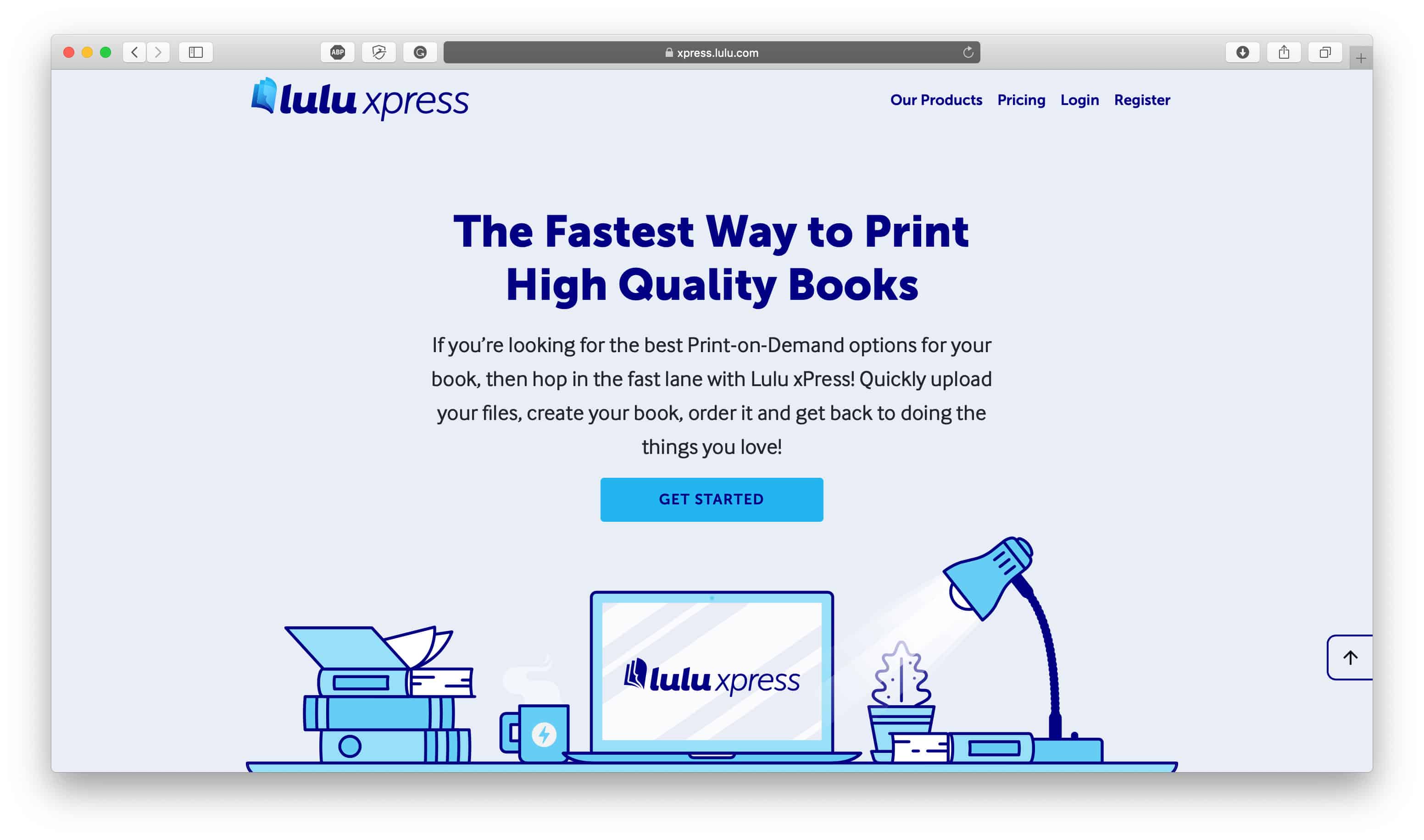
With over 3,000 different configurations to choose from, you’ll undoubtedly find everything you need to bring your planner to life.
Lulu xPress’ Book Sizes:
- US Trade (6 x 9 inches)
- US Letter (8.5 x 11 inches)
- Digest (5.5 x 8.5 inches)
- Executive (7 x 10 inches)
- A5 (5.83 x 8.27 inches)
- A4 (8.27 x 11.69 inches)
- Royal (6.14 x 9.21 inches)
- Crown Quarto (7.44 x 9.68 inches)
- Square (8.5 x 8.5 inches)
- Small Square (7.5 x 7.5 inches)
- Pocketbook (4.25 x 6.875 inches)
- US Letter Landscape (11 x 8.5 inches)
- A4 Landscape (11.69 x 8.27 inches)
- Small Landscape (9 x 7 inches)
- Calendar (11 x 8.5 inches)
Lulu xPress’ Binding Options:
- Perfect Bound: 32 to 800 pages (this is industry jargon for traditional paperback binding)
- Coil Bound: 2 to 470 pages (a flexible, black plastic coil)
- Saddle Stitch: 4 to 48 pages (the pages inside the planner are folded and inserted between the cover, then stapled along the spine)
- Hardcover Case Wrap: 24 to 800 pages (traditional hardcover binding with a printed image on the front)
Lulu xPress’ Color Options (inside of the planner):
- Standard Black and White: Ideal for mostly text-focused pages with few to no images
- Standard Color: Ideal if you have a few color images, graphs, or illustrations
- Premium Black and White: Ideal for more substantial texts
- Premium Color: Ideal for image-heavy content with heavy ink coverage on the pages
Lulu xPress’ Paper Types:
- 60# Cream – Uncoated: Traditional cream-colored paper
- 60# White – Uncoated: Versatile and budget-friendly white paper
- 80# White – Coated: Ultra-smooth, bright white and slightly thicker
Then once you’re done creating your prototype, you can have it shipped to you. Lulu xPress ships to over 150 countries, so there’s a good chance they’ll ship to your location. Generally, you should expect to wait between 3 to 5 days to receive your product in the mail.
Blurb
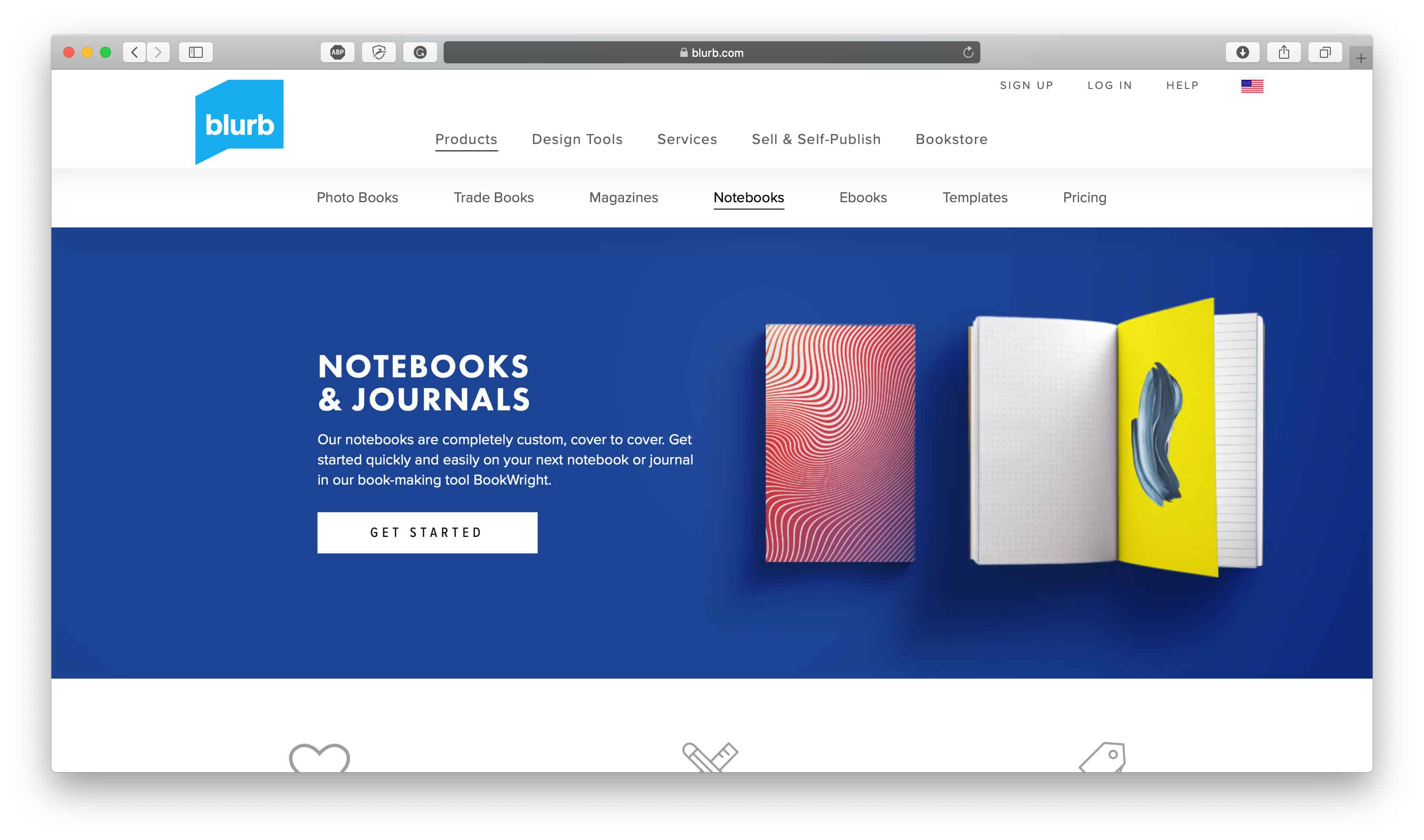
Alternatively, you can use a site like Blurb to create your planner business prototype. They have a template for a yearly journal that you could easily use as a framework for your planner. You can include up to 480 pages, quotes, and prompted pages.
Blurb partners with a company called BookWright, so to get started, head over there then select “Create” followed by the “Notebooks” button. From there, Blurb provides you with everything you need to create your planner!
As a general rule, their journal paper comes uncoated and in their standard color, #70 text stock.
When it comes to Blurb’s covers, you can choose from:
- A softcover
- A hardcover with a dust jacket
- A hardcover on its own
You can also select from the following sizes:
- 5 x 8 inches
- 6 x 9 inches
- 8 x 10 inches
Now it’s Time to Find a Supplier for Your Planner Business
To make it easier for you, we’ve ranked all of the different kinds of planner business suppliers from the most straightforward to the most complex. Hopefully, the information below will help you decide on the best sourcing method for your planner business.
Print-on-Demand
Print-on-demand is probably the least complex and most accessible option. Not only can you customize your planner (to a degree) but the packaging and shipping of your products are also handled by your supplier. This process is also known as dropshipping.
This is how it works:
- You customize the planner product and then list it on your website and market it
- A customer makes an order
- You notify the print-on-demand company about said order
- They then ship the order directly to your customer on your behalf
Yes, it really is as easy as that.
However, you should note, the main downside to print-on-demand is that the costs are usually higher, meaning that your profit margins are generally lower. Plus, you probably won’t get as much control over the customization of your planner (in comparison to going down the “full-scale design and production” route which we discuss in more depth below) because your supplier will keep it pretty standardized.
The print-on-demand business model does mean that you won’t have to order inventory in advance—you only purchase inventory from your supplier after a customer places an order with you—which makes it more a more accessible option for people who don’t want to purchase large quantities of inventory upfront.
Here are a couple of print-on-demand companies you should check out:
Gooten
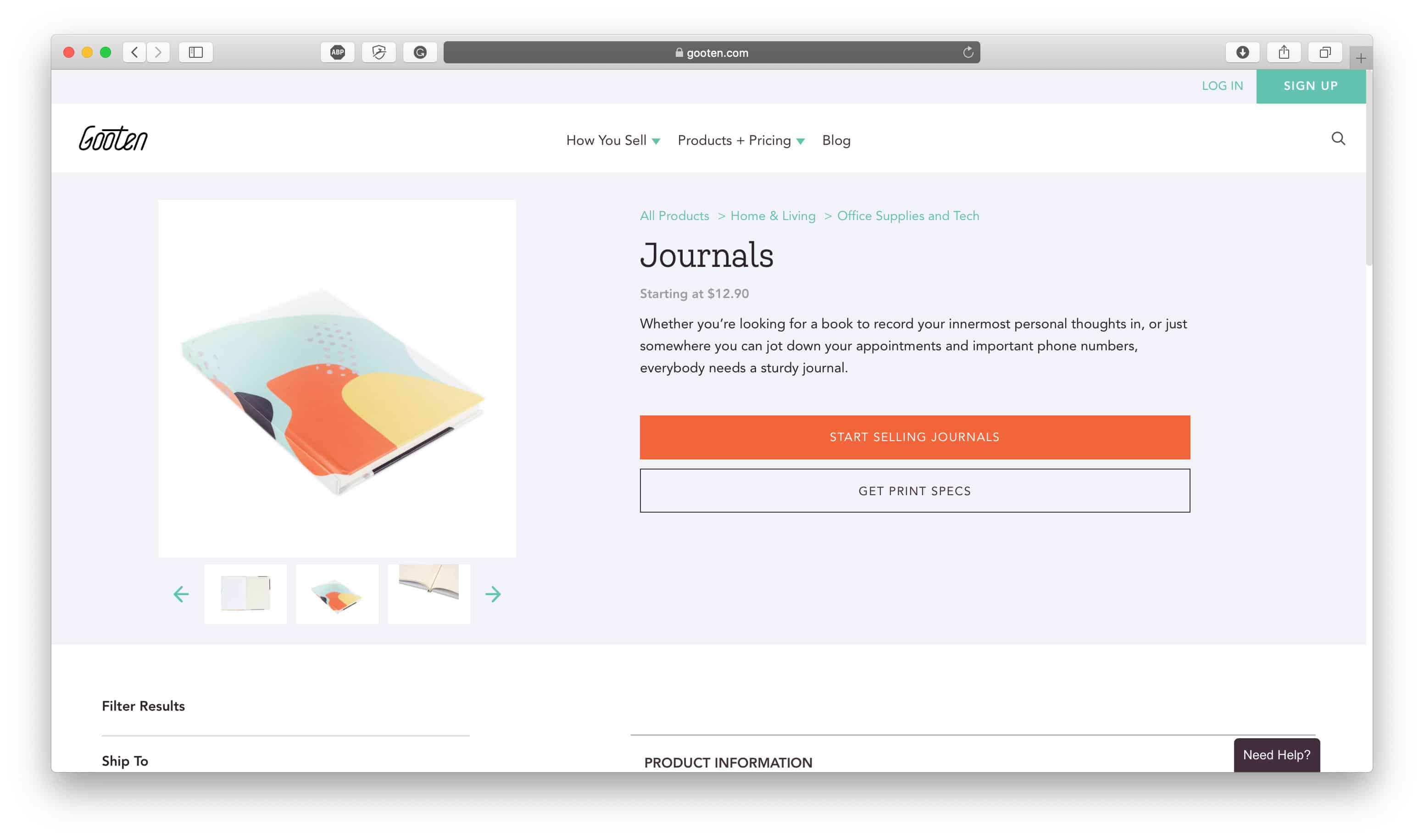
Presently, Gooten only supplies blank notebooks and journals. However, with the right design, you could probably market them as planners.
Zazzle
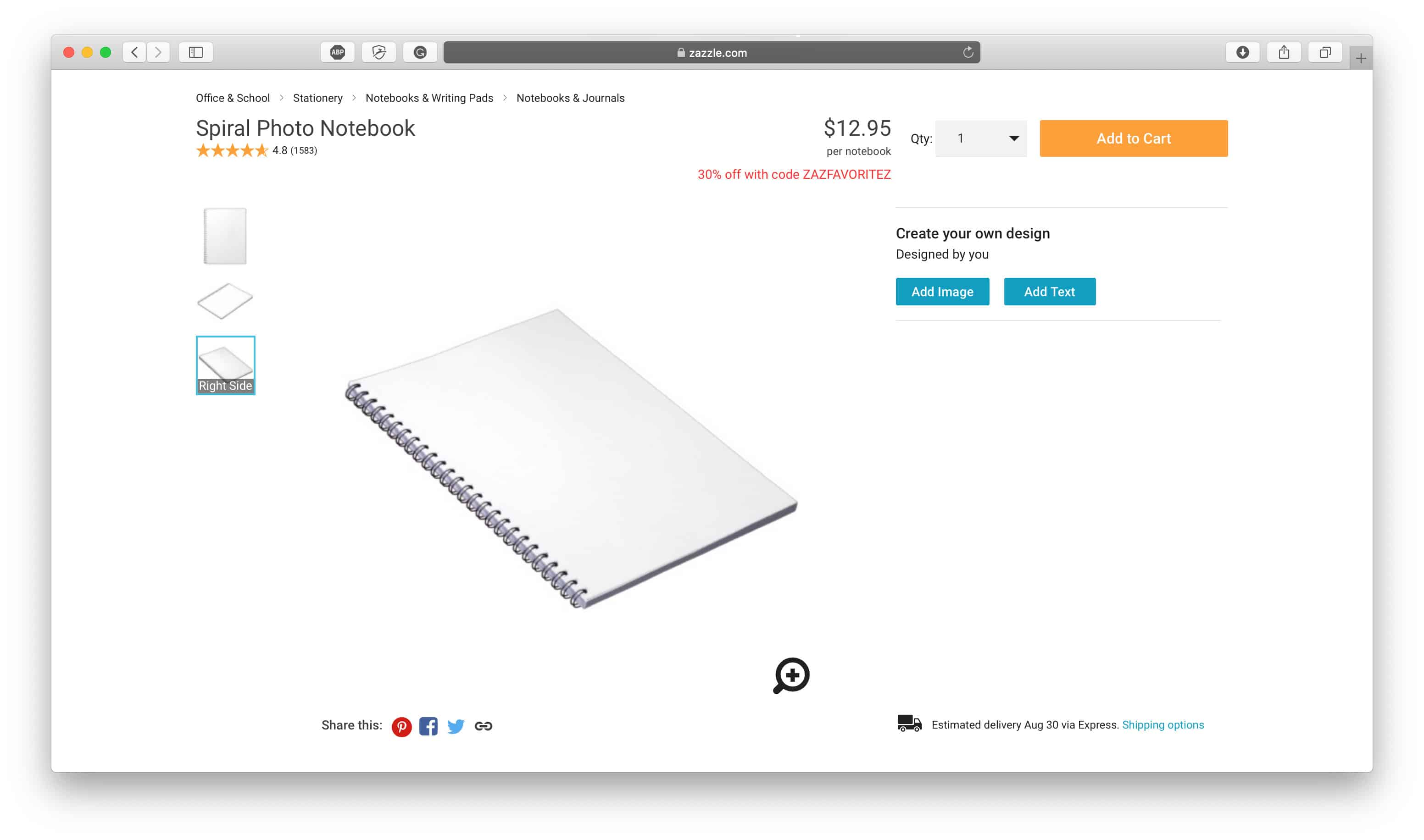
Zazzle is a great print-on-demand supplier for creating and shipping planners because Zazzle planners boast all of the following features as standard:
- Size: 5.5″ x 8.5″ (so relatively small)
- Monthly and weekly planner sections that span 12 months
- A sheet full of fun and colorful stickers. These are placed in the back of the planner
- 60 pages
- A softcover front and laminated back covers
- Wire-o® spiral spine (available in white, black, or gold)
- You can either upload your own cover designs or use the images and patterns uploaded by other Zazzle members
Zazzle is free to use. You can either set up a store using their platform or integrate Zazzle with whatever ecommerce platform you’re using to host your online store.
Dropshipping
Alternatively, if you’re not too worried about customizing your planner’s design, you could search through dropshipping supplier directories. Then once you find a planner you like the look of, dropship the products directly to your customers.
If you’re going down this route, Spocket (Spocket Review) is probably your best bet.
Put simply, Spocket is a dropshipping app you can integrate with either a Shopify or WooCommerce store. Spocket primarily deals with suppliers located in the US, UK, and EU, which is what makes them different from the majority of dropshipping apps that focus on AliExpress suppliers.
To find a planner you like the look of, just head over to Spocket’s search bar and type in “Planners” and plenty of results will pop up. When you find planners you like, you can then order a sample from the supplier so you can see it in real life. Once you’re satisfied with the product, import the product listing and images to your ecommerce store and start selling the planner!
All of Spocket’s products boast pre-negotiated discounts (some as large as 60% off of the retail price). Not to mention, you can also offer shoppers swift delivery times (2-5 days) because 70% of Spocket’s suppliers are in the US and Europe.
Best of all, you can get started with Spocket for free. Their free plan entitles you to:
- Import up to 25 Spocket products onto your ecommerce store
- Receive an infinite number of product orders
- Access to Spocket’s global pricing rules
- Tracking numbers for all shipments
- Customer support via email
How awesome is that?!
Full-Scale Design and Production (Manufacturing)
This sourcing option means that you have to organize every aspect of your planner business yourself—from designing planner products to order fulfillment, it all comes down to you. Don’t let that scare you away though because as you go through the rest of this article, you’ll find advice to help you at each stage of the way.
When sourcing via full-scale design and production, you’ll likely source your inventory of planner products upfront from a supplier. To do this, you’ll need to work with the supplier to create your planner products from scratch, you’ll need to meet the supplier’s minimum order quantities (MOQs) when ordering inventory, and you’ll also need to have a shipping and fulfillment plan in place.
There are a few ways to find manufacturers who can create products for your planner business:
- Source from Alibaba manufacturers
- Source via a third-party organization like Sourcify
- Source manufacturers through directories
We discuss each option in further detail below.
How Do You Find Trusted Suppliers on Alibaba?
Sourcing from Alibaba can be tricky. Our advice is to look for specific supplier types and use Alibaba’s supplier filters to increase the likelihood of finding high-quality suppliers.
Here are some of the filters you’ll want to check:
Trade Assurance Suppliers
When you do business with a trade assurance supplier, you’re covered if:
- Your products aren’t shipped on time
- The products don’t meet your quality standards
In the unfortunate event either of these happens, Alibaba will pay for the goods.
Gold Suppliers
Gold suppliers are merchants who have paid a $10,000 fee to become listed as a “Gold Supplier” on the Alibaba supplier marketplace in the hopes of better promoting their products. Needless to say, suppliers who are willing to pay $10,000 aren’t as likely to scam you but there are still no guarantees. It’s just another way to reduce the likelihood of getting scammed.
Assessed Suppliers
When it comes to Alibaba suppliers, these are the best of the best. They’re all either Chinese, Hong Kong, or Taiwanese Gold Suppliers that have all been investigated on-site by a third-party inspection company.
They also have to provide the following information to comply with Alibaba’s Factory Audits:
- Assessment Reports
- Verified Videos
- Verified Main Products
Check the Supplier’s Background
Head over to their website and try and find the following details:
- Their business license
- Their location
- Their ownership status
- Photos and/or videos of the supplier’s operations
- Legitimate contact info
In addition to this, you should do a Google search with the supplier’s name + “scam.” This should tell you whether other buyers have been caught out by them before.
Analyze Their Page on Alibaba
Head over to their page on Alibaba and ask yourself the following questions:
- Does the page look professional? Is it structured well?
- Have they published several product pictures? Does the quality of their images look professional?
- Do they describe their products and factory in-depth?
- Do they specify where they’re based?
- Do they outline their quality control process?
These questions can give you a better indication of whether a potential supplier is worth pursuing. If something doesn’t feel right then look elsewhere.
Ask for References
We also suggest contacting the supplier directly and asking them to provide you with references from previous customers. Decent suppliers shouldn’t have an issue with providing glowing customer testimonials. If they’re unable to do that for you, cut your losses and find another potential supplier.
Have You Considered Using Sourcify?
If you’re looking for an easier way to find the perfect supplier for your planner business, you might want to check out Sourcify.
This is how Sourcify works:
- Submit Your Project: Define your product, design, specs, and any other requirements and then receive bids from factories Sourcify has matched you with. Once you like the look of a potential factory, order a product sample.
- Approve Your Sample: Once you receive your sample, you can then send over any changes you’d like. Then when you’re happy, approve the final sample with your factory. The factory will then send you a production invoice and request that you pay the pre-production balance.
- Start Production: During this stage, you can monitor production updates and converse with factories about any production changes. Then, once your planners are produced, you’ll be notified. All that’s left to do is settle the remaining production balance.
- Receive Your Products: Get your products delivered to you or your fulfillment warehouse so they can be prepared to ship to your customers!
Best of all, Sourcify goes to the trouble of pre-vetting these factories beforehand, so you’re way less likely to do business with a bad manufacturer.
Use Manufacturer Directories to Find Planner Suppliers
Another great way to find suppliers who can create bespoke products for your planner business is by looking through supplier directories like our Manufacturers Directory. Here, you’ll find a list of manufacturers who you can check out to see if they have the capabilities to produce the kinds of products you’re looking to make.
Get a Sample Made for Your Planner Business
No matter how you choose to source products for your planner business, it’s always a good idea to get a sample made/sent to you so you can thoroughly analyze it to ensure it meets your specifications.
However, before you jump right in and request a sample, you’ll need to be aware of the following to ensure that you get what you actually asked for. When contacting suppliers, be sure to ask them the following in your email:
- The exact specifications of the product. Try to be as detailed as possible about dimensions, covers, bindings, paperweight, materials, extra additions, etc.
- The shipping address you want the supplier to send your sample to
- Request a model number and company name tag so you can differentiate their sample from other suppliers
- Ask how long the supplier takes to send samples and when should you expect to receive it
Now that we’ve covered the basics, you might be interested to know there are different types of samples you can request:
- Factory Samples: These are products that the supplier’s already going to make. As such, they don’t have to go to the effort and expense of manufacturing items specific to your brief. This is an excellent option if you’re producing a planner that doesn’t require much (if any) customization.
- Pre-Production Samples: These are pretty much essential if you’re customizing a planner because you need to test whether a manufacturer can produce something that matches your specifications. After all, you don’t want to order a whole batch of planners until you’re confident the supplier will get everything just how you want it.
Ordering Inventory
Once you’re happy with your sample, you’ll be ready to order inventory. There’s a good chance your supplier will have MOQs which refers to the smallest number of units your supplier will produce for you at any one time. Check out our article for more info on why MOQs are essential, their advantages, disadvantages, and how to negotiate them.
Warehousing, Shipping & Fulfillment for Your Planner Business
Somehow, your product needs to get into your customers’ hands which is where warehousing, shipping, and order fulfillment comes in.
In short, you have two options:
- You can sell a product from a dropshipper who then fulfills orders on your behalf
- You fulfill your own orders, meaning you work alongside a logistics company who handles warehousing and other order fulfillment tasks
Many logistics companies will happily store your products, pack them, and then ship the orders as they come in. Not to mention, if you already have a Shopify store, tons of apps will integrate your online shop with third-party logistics services.
Needless to say, you’ll enjoy the benefit of not having to bother with these jobs. But, more than that though, you’ll also reap the advantages of:
- Flexible Pricing: Most logistics companies offer clients flexible pricing. So, as your business grows (or goes through slower periods) and the service you require varies, as will the price. This is usually nowhere near as much of a financial commitment as renting your own warehouse.
- Avoid the Hassle of Recruiting: If you plan on fulfilling and shipping your own customer orders, you’ll eventually need to hire staff to help you out. Recruiting, training, and managing a team takes time—which is why outsourcing to a logistics company can be a much-welcomed relief.
- Focus on Your Strengths: We don’t mean to make assumptions, but there’s a good chance you didn’t launch your business because you love packing boxes. As such, handling your own shipping can often be a drain on your precious time, which is better spent growing other areas of your business.
This is why outsourcing to companies that specialize in shipping and fulfillment is important. By shedding the responsibility of this monotonous task, you can spend more time on activities that directly boost your bottom line.
The same principle also applies to handling refunds and returns so you’ll be pleased to hear that the majority of third-party logistics companies also manage these issues on your behalf—freeing up even more of your time!
When Should You Use a Third-Party Logistics Company?
It can be tricky to put your finger on when to start outsourcing this task so we’ve listed a few scenarios where you might benefit from using a professional warehousing and shipping company:
- Your Sales are Sporadic: If your sales rate fluctuates throughout the year, it usually isn’t worth managing and staffing your own warehouse—as such, outsourcing is probably the best way to go.
- You’re Time-Poor: Most entrepreneurs are time-poor. However, if you’re spending the majority of your time handling order fulfillment tasks and not on activities that actually grow your business, you’re probably ready to start outsourcing.
- You Don’t Have the Infrastructure: If your business is rapidly snowballing, you run the risk of outgrowing your current infrastructure, which leaves little room for growth. If you can relate, outsourcing to a company that specializes in logistics is usually a wise decision.
How Do I Choose a Shipping and Fulfillment Company?
It’s always best to find and use a company with experience working with other planner or stationery-themed ecommerce stores so reach out to the logistics service you’re considering and chat about the nature of your business. During the conversation, be sure to also:
- Ask for references
- Specify your exact needs
- Ask any other questions you may have
This is usually the most reliable way of getting a better feel for the kind of service you’ll receive.
Printful Shipping & Logistics
Have you considered using Printful?
If you’ve done any research on the print-on-demand business model, you’ve probably come across Printful (Printful Review). However, did you know they also offer warehousing and fulfillment services for products like planners?
Printful will store your products in their warehouses, fulfill your orders, and ship merchandise directly to your customers on your behalf.
Best of all, Printful can get your orders out as fast as in one day! They offer same-day shipping for orders placed by noon—which is excellent for improving the customer experience provided to shoppers.
Not to mention, it’s free to sign up, and there aren’t any account maintenance fees.
Printful users report that their support team is incredibly helpful and friendly. So, if you get stuck or have a question, there’s no need to worry!
The following is a more in-depth look into how shipping and fulfillment with Printful works.
Send Printful Your Products
First things first, you need to send Printful the products you want them to warehouse and ship on your behalf. Printful will then either approve or disapprove the items. If they accept your products, you can then go ahead and send them a full shipment.
Printful Looks After Your Items
Once Printful receives your shipment, they’ll store your goodies in their warehouse. From there, you can sync product levels with your online store and start selling.
You can choose to store products in Printful’s fulfillment centers located in:
- Charlotte, USA
- North Carolina, USA
- Riga, Latvia
So, selling to an international audience is a breeze!
Printful Fulfills Orders on Your Behalf
When a customer makes an order, Printful ships the necessary products from their warehouse directly to your customers. To automate this process, Printful integrates with over 14 ecommerce solutions, including:
- Shopify
- Etsy
- WooCommerce
- WordPress
- Squarespace
- Amazon
- Ecwid
- Weebly
- Inktale
- Storenvy
- BigCommerce
- ShipStation
- Gumroad
- BigCartel
- eBay
- Prestashop
- Magento2
- Wish
So, there’s a good chance you’ll be able to connect Printful to your online store.
How Much will Printful Set Me Back?
Here’s a quick breakdown of how much Printful’s warehousing and order fulfillment services cost:
Processing and Fulfillment Fees:
- Fulfillment fee (per package for an item from the warehouse): $2.00 USD or €1.75 Euro
- Picking a product (per item in an order) $0.95 USD or €0.80 Euro
- The receiving, processing, and barcoding of your products is entirely free!
- Packaging materials are charged at cost
Storage Fees:
- 1 to 200 Units: In the USA is $1.65 per cubic foot of storage ($25 monthly minimum) or in Europe is €1.40 per cubic foot of storage (€22 monthly minimum)
- 201-1000 Units: In the USA is $1.30 per cubic foot of storage ($25 monthly minimum) or in Europe is €1.10 per cubic foot of storage (€22 monthly minimum)
- 1001-10,000 Units: In the USA is $1.00 per cubic foot of storage ($25 monthly minimum) or in Europe is €0.85 per cubic foot of storage (€22 monthly minimum)
- 10,000+ Units: In the USA is $0.75 per cubic foot of storage ($25 monthly minimum) or in Europe is €0.65 per cubic foot of storage (€22 monthly minimum)
So, as you can see, the more you store, the better value the rate is.
You’ll also be happy to know that Printful partners with numerous global carriers—all of which offer a decent range of quick and budget-friendly shipping options:
- USPS
- FedEx
- DHL
- APC
Creating Your Online Planner Business Store
When it comes to creating an online store, you have lots of options:
- Shopify
- BigCommerce
- Etsy
- Amazon
- Social Media Stores
More often than not, it’s best to use a variety of the above. This is what we call “multi-channel selling.”
So, let’s delve into each of these platforms in greater detail.
Shopify
Shopify is a subscription-based software that empowers online sellers to create a website that integrates with a digital shopping cart. This makes selling, shipping, and managing stock an effortless task. Best of all, you can benefit from Shopify’s free trial so you don’t have to part with your hard-earned cash before you’re confident that you like the service they provide.
Advantages of Shopify:
- Shopify’s interface is incredibly intuitive, so you don’t need any technical know-how to get up and running. Within minutes you can customize your online store to reflect your brand. They even have professional-looking themes you can use to make your site look incredible.
- Shopify has a reliable infrastructure which ensures your ecommerce store loads in a matter of seconds.
- Shopify integrates with thousands of different apps which makes adding extra features and extending the functionality of your site super easy.
Disadvantages of Shopify:
- For entrepreneurs with a limited budget, Shopify might significantly eat into your funds, however, when you consider that you get web hosting and a web domain included within the price, it’s actually pretty reasonable!
- Shopify offers users plenty of features (which once you get to grips with the platform is a bonus), however, this can be a tad daunting for newbies. If you find their amount of features overwhelming, set aside some time to learn the ropes—trust us, it’ll be worth it in the end! Start with our comprehensive Shopify Review to learn about their most noteworthy features.
BigCommerce
A similar alternative to Shopify, BigCommerce is another ecommerce platform that provides you with a web domain and hosting for your online store.
Advantages of BigCommerce:
- BigCommerce has an app, so you can manage your store while you’re on the run (in addition to using your desktop).
- BigCommerce isn’t as costly as Shopify.
- eBay, Amazon, and Facebook integrations are available for BigCommerce which makes syncing your online sales across all these platforms much more manageable.
Disadvantages of BigCommerce:
- BigCommerce’s website templates store isn’t as comprehensive as some of their competitors.
- There also aren’t as many plugins available for BigCommerce users so you may be limited when it comes to extending the functionality of your store.
Etsy
There’s a good chance you’ve heard of Etsy before and it may just be the platform for you if you’re hand-making your planner or designing one with a vintage flair.
Advantages of Etsy:
- Etsy has a fabulous community feel to it, making it a fun platform to get involved with.
- You’ll typically attract a higher-quality customer. On the whole, shoppers genuinely respect this online marketplace because Etsy sellers have lots of opportunities to build rapport with their customers.
- You’ll find your audience. Even if your niche planner is a bit unique, there’s a good chance you’ll find a market for it on Etsy.
Disadvantages of Etsy:
- New sellers often struggle to get themselves noticed on Etsy, so it could be a while before you turn a profit on this platform.
- Etsy requires you to pay a variety of fees such as for publishing a listing, making a sale, as well as credit card fees. Needless to say, these expenses can quickly add up.
- Users report Etsy’s search feature is a tad awkward—and we all know how important providing excellent user experience is.
- Last but not least, Etsy sellers sometimes complain about too many sponsored items popping up on search results. This can distract customers from looking at your listings, leading to a decrease in traffic and, therefore, fewer sales.
Amazon
Amazon makes it simple for online sellers to jump right into the ecommerce world.
Advantages of Amazon:
- Amazon boasts an international reach, making it a fabulous place to extend your audience.
- As a merchant, you’ll be pleased to hear that Amazon’s customer support is second to none. They have plenty of agents in a variety of countries, so you’re bound to connect with a rep in your time zone.
- You can store inventory in their fulfillment centers (as a Prime seller) so you don’t have to deal with the hassle of shipping and fulfillment.
Disadvantages of Amazon:
- There are hundreds of sellers on Amazon because the marketplace is so big, so it’s easy to be overlooked. So, if you don’t have the best prices or if your product has shipping costs, Amazon customers (especially customers who have Prime) may overlook you.
- Amazon is by far the priciest option on this list. In addition to charging you fees on each product you sell, you also have to pay around $500 a year just to publish your product catalog!
Social Media Stores
When we think of social media stores, Facebook likely springs to mind. This is hardly surprising considering its the most popular social media platform on the planet. Well, businesses can now add a shop to their Facebook page and sell to customers directly. You can even integrate your Shopify store, so you don’t have to keep two different inventories!
Advantages of a Facebook Store:
- There are thousands of users so there’s a good chance you’ll find and appeal to your target market.
- It’s easy to customize your Facebook shop to reflect your brand’s aesthetic.
- Customers can contact you directly with their questions and queries.
- Facebook analytics are pretty thorough.
Disadvantages of a Facebook Store:
- Loading times in comparison to other platforms are reported to be pretty slow.
- Unless you have any web development skills, getting your Facebook store to look just how you want it can get pretty expensive.
Selling & Marketing for Your Planner Business
There are tons of ways you could market and sell your planner business, but have you considered making it into a subscription box? Since planners and planner accessories are used on a monthly or yearly schedule, they can easily become a subscription box product.
Subscription boxes are great because they boast higher customer retention rates. When you consider that 15% of online consumers signed up for an ecommerce subscription over the last year, you soon understand that there’s a lot of money to be made! And as you probably already know, it’s more cost-effective to retain existing shoppers than to obtain new ones and by offering a subscription box, you’ll be more likely to keep customers around for longer.
They do this because they provide natural opportunities to engage with your community on a regular basis. They’re all about getting customers to commit to an on-going buyer/seller relationship rather than one-off purchases. So, providing that you’re selling the right product and offering shoppers an excellent customer experience, retention shouldn’t be too tricky!
Consequently, you don’t have to spend loads of time trying to market your planners to get customers to keep purchasing products. With all the time you’ve saved, you can focus your energy on designing and developing new products and providing customers with awesome customer service.
Following are a few other marketing tips that are a perfect fit for a planner business.
Use Pinterest for Your Planner Business
Pinterest marketing for a planner business can be incredibly lucrative. Again, the stats speak for themselves:
- 59% of millennials have stumbled across products on Pinterest
- 90% of weekly Pinterest users use this platform to help make purchasing decisions
- 55% of Pinterest users search specifically for products on this platform
In light of this, you’ll want to get your Pinterest business account up and running.
Do you already have a personal account? If so, you can easily convert this into a business account. The advantage of doing this is that you won’t lose any boards you’ve already created or the pins you’ve saved.
Alternatively, you can create a fresh business account. Just follow the steps Pinterest takes you through.
Part of this process is claiming your website. You don’t want to skip this step because it enables you to:
- Automatically add your profile picture to any images pinned from your site
- Integrate with your website’s analytics, so you can see the content visitors are saving from your site to their Pinterest accounts
- Enjoy greater exposure to other Pinterest users. Pinterest openly says; “If you use and have a confirmed account, your pins appear higher in search results,” how awesome is that?!
How Do I Claim My Site on Pinterest?
There are two ways to claim your site:
- You can use a meta tag
- Or, you can upload an HTML file
For more detailed instructions on how to do this, head over on Pinterest’s Claim Your Website help page.
Why Do I Need a Pinterest Business Account?
If you’re taking marketing on Pinterest seriously, you’ll want access to all the additional features that come with a business account. For instance, you’ll unlock the ability to advertise, Pinterest’s analytics, and a broader array of pinning options.
In fact, business users have five different types of pins they can use, however, we’re only going to explore four of them, as the Shop the Look pin isn’t relevant for selling planners (these are uniquely designed for the fashion and home decor categories).
Standard Pins
Just like the name suggests, these are just regular pins. Standard pins are the only kinds of pins non-business accounts can post.
Standard pins display:
- A link
- Title
- A description
That’s about it.
Promoted Pins
These are more like ads that business users can pay for. This helps to ensure your target audience actually gets exposed to your content. They look like standard pins to other Pinterest users, but they work a lot like PPC ads.
Rich Pins
For selling planners, Rich Pins are probably going to be your best bet. They’re highly optimized pins that offer a far more engaging user experience, namely because they provide much more context to the potential pinner.
Interestingly, there are four types of Rich Pins: App, Product, Recipe, and Article. The Product option (and potentially the Article option, if you’re running a blog on your store) will be the Rich Pin best suited to marketing your planner business.
Here’s a little more information on these two options:
- Product: These make online shopping way easier for Pinterest users. They provide info about pricing, product availability, and purchasing details.
- Article: These pins highlight where the article has been sourced, the headline, author, and briefly describes the blog post.
You’ll need to validate your website URL and get it authorized to be able to use Rich Pins. Pinterest provides more information on how to do that over in their help center.
Buyable Pins
These are very similar to Product Rich Pins, however, with a Buyable Pin, a customer (using either a mobile device or a desktop) can purchase products without leaving Pinterest. Best of all, Pinterest doesn’t even take a cut of the sales you make!
You can also integrate buyable pins with your online store so your order fulfillment process isn’t disrupted.
Add a Pinterest Save Button to Your Site
Making it simple for website visitors to share images on Pinterest is hands-down the easiest way of circulating your content on Pinterest.
This is how it works.
Once you install a Pinterest Save Button, a clickable logo is displayed on all the images published on your website. When visitors click on the logo, they can then save your content directly onto their Pinterest boards.
Best of all, every time a user saves a pin using the Save Button, their followers also see the content they’ve collected. This works wonders for bolstering traffic to your site and gaining more exposure on Pinterest.
Interestingly, there are two types of Pinterest Save Buttons:
- Automatic Buttons: As the name suggests, this is where Pinterest’s Save Button logo appears on your images automatically (without the visitor taking any sort of action).
- Hover Buttons: Conversely, this is where Pinterest’s Save Button only appears on images when visitors hovers their cursor over the image. This is the better option if you’d prefer to keep your Pinterest marketing covert. You can also modify the aesthetic of Pinterest Save Buttons to complement your branding.
Once you have a Save Button installed, you can use Pinterest’s analytics to see which images visitors are pinning. With this data at your disposal, you’ll find it easier to refine and improve your content marketing strategy.
Automate Your Pins
Consistency is the key to successfully marketing yourself on Pinterest. In fact, experts suggest you should pin anywhere from 11 to 20 times per day!
Pinterest gurus suggest 80% of what you post should be re-pinned from other Pinterest users, and the other 20% your own original content. But don’t just publish product photos—this isn’t the most efficient way to grow your following on Pinterest.
Instead, pin product-related stuff like infographics and blog posts brimming with valuable information, in addition to content specific to your planner business. Over time, this technique should acquire new customers and help retain your existing ones.
Understandably, pinning 11 to 20 times a day may sound like a lot. This is why automating the process comes in handy. Without it, you run the risk of losing momentum. Use scheduling tools like Buffer to help. This kind of software makes it easy to keep on top of your social media marketing.
Pinterest Pincodes
What are Pincodes?
Well, they’re unique codes that work a bit like QR codes. So, as you may have already guessed, they help prospects find both your brand and products on Pinterest.
You can place Pincodes on any of your physical marketing materials, for example:
- Product catalogs
- Brochures
- Business cards
- Product packaging (for selling planners online, this is probably the most effective way of using pincodes)
You get the idea!
Then, whenever someone scans your Pincode with their Pinterest app, they’ll be taken directly to your content.
Optimizing Your Pins
Pinterest, just like Google, works just like a search engine so you can employ SEO tactics to extend your reach.
This means doing a bit of keyword research.
The titles and descriptions of your pins are (primarily) how other Pinterest users stumble across your content. So, optimize both these pieces of copy with keywords your target audience is searching for.
To find high-converting keywords, use a tool like KWFinder. This is our favorite keyword research tool because it’s thorough, accurate, and has a user-friendly interface. Check out our KWFinder Review to learn more about why it’s one of the top keyword research tools out there.
In addition to using keywords, you’ll also want to utilize hashtags. Again, these also help people discover your pins. These are most effective with content that’s already optimized for high-converting keywords so don’t rely solely on hashtags to get your planner business found on Pinterest!
Remember, however, that hashtags are clickable, which means they can take users away from your content so you don’t want to bombard your pins with them. Instead, we suggest using a maximum of two hashtags per pin.
In addition to all the above, you’ll want to optimize the size of your images. This means using a vertical aspect ratio with the recommended 2:3—600px wide x 900px high. When you stick to these ideal dimensions, you’ll take up more space using Pinterest’s kanban format. So it stands to reason, you’re more likely to capture the eyes of people scrolling through their feed. Check out Canva’s templates for the ideal Pinterest image size.
Video Marketing for Your Planner Business
You can also use video marketing to advertise your planner business. Here’s how:
Have a Plan
The age-old adage “fail to plan and plan to fail” is accurate in this case, and launching video marketing campaigns are no exception.
Before you do anything else, do some research. Get to know your target audience inside out. This is the only way to achieve an in-depth understanding of what your target demographic is struggling with, and how you can offer them a solution with your planner products.
Write a Script
Once you have a topic in mind, you’re now in a position to write a script.
Keep things simple. Use language your audience can resonate with, such as the kind of lingo you’d use in everyday conversations. This helps to give your video a more natural feel to it.
Before you start shooting, read your script aloud. You’ll soon tell whether the narration flows. If you find yourself tripping over words, go back to the script and edit it until the words spill out naturally.
Record Your Narration
If you don’t have one already, buy yourself a cheap mid-range microphone. You can get pretty decent ones second-hand for a fraction of the cost. Head over to Amazon and eBay to see what you can find. You’ll be astounded at how much better the audio quality is, in comparison to using the mic built into your computer.
Now, find a quiet place to record. Ideally, somewhere you won’t get disturbed or distracted.
Use your preferred video editor and record your voice over. Don’t forget to speak both slowly and clearly into the microphone. This is a surefire way to achieve the best quality audio.
Record Your Video and Edit
Now record the visual content of your video. Once you’re finished, play it back on your editing software. Cut out any mistakes or unnecessary footage.
When you’re happy with both your video and audio, sync them together. Save the video and publish it on the platform of your choice—say, Facebook, YouTube, Instagram, etc.
It really is as simple as that!
Ready to Start Your Planner Business?
We hope having read this mammoth guide, you now feel as though you’re in a better position to kickstart your planner business. Planners are one of the top rising product niches at the moment so if you’re looking to create an in-demand product that you can tailor to your own audience, then starting your very own niche planner business could be something to seriously consider. Dive in sooner rather than later to really capitalize on this growing market!

